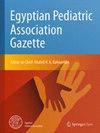新生儿败血症--尼日利亚西北部的调查结果:一项前瞻性研究
IF 0.5
Q4 PEDIATRICS
引用次数: 0
摘要
新生儿败血症仍然是全球关注的健康问题,因为它导致了新生儿的高发病率和高死亡率,尤其是在发展中国家。本研究旨在深入了解新生儿败血症:风险因素、败血症类型、临床特征、病原体负担及其抗生素敏感性,以及本院的入院结果。该研究是一项基于医院的前瞻性研究,历时10个月,即2018年10月至2019年7月。在248名具有败血症特征的足月新生儿中,有94名(37.9%)被证实患有败血症。研究发现,晚期败血症 LOS(68%)最为常见,大多数新生儿在其他地方分娩。早发(EOS)和晚发(LOS)的临床特征均无特异性,包括发烧、黄疸、吸吮不良和原始反射减弱。感染主要由革兰氏阴性菌引起,金黄色葡萄球菌是 EOS 和 LOS 最常见的分离菌。在 EOS 和 LOS 中,环丙沙星的抗生素敏感性最高。死亡率高达 14.9%,主要是金黄色葡萄球菌感染所致。新生儿败血症仍然是一种负担,其临床特征大多不具特异性。当地流行的病原菌是金黄色葡萄球菌、聚合肠杆菌和肺炎克雷伯菌,它们对环丙沙星具有良好的抗生素敏感性。大多数患者都是晚期败血症,因此很可能是社区获得性感染,而这种感染在很大程度上是可以通过强有力的公共卫生干预措施加以预防的。本文章由计算机程序翻译,如有差异,请以英文原文为准。
Neonatal sepsis-a peek into our findings in Northwest Nigeria: a prospective study
Neonatal sepsis is still a global health concern as it contributes to a high burden of neonatal morbidity and mortality especially in developing countries. The aim of the study is to give an insight into neonatal sepsis: risk factors, sepsis types, clinical features, pathogen burden with their antibiotic sensitivities, and outcome of admission in our facility. The study was a prospective hospital-based study conducted over 10 months, October 2018–July 2019. Of the 248 term neonates with features of sepsis enrolled in the study 94 (37.9%) were confirmed to have sepsis. Late-onset sepsis LOS (68%) was found to be the most common, and most of the neonates were delivered elsewhere. Clinical features were non-specific for both early-onset (EOS) and LOS and include fever, jaundice, poor suck, and depressed primitive reflexes. Infections were mostly caused by gram-negative bacteria, and while Staphylococcus aureus was the single most common isolate for both EOS and LOS. Antibiotic sensitivity was highest with ciprofloxacin for both EOS and LOS. Mortality was high at 14.9% and was mostly contributed to by Staphylococcus aureus infection. Neonatal sepsis is still a burden with mostly non-specific clinical features. The local prevalent organisms were Staphylococcus aureus, Enterobacter agglomerans and Klebsiella pneumonia with good antibiotic susceptibility to ciprofloxacin. Most presented with late-onset sepsis and therefore infection is likely to be community-acquired which to a great extent can be prevented with robust public health interventions.
求助全文
通过发布文献求助,成功后即可免费获取论文全文。
去求助
来源期刊

Egyptian Pediatric Association Gazette
PEDIATRICS-
自引率
0.00%
发文量
32
审稿时长
9 weeks
期刊介绍:
The Gazette is the official journal of the Egyptian Pediatric Association. The main purpose of the Gazette is to provide a place for the publication of high-quality papers documenting recent advances and new developments in both pediatrics and pediatric surgery in clinical and experimental settings. An equally important purpose of the Gazette is to publish local and regional issues related to children and child care. The Gazette welcomes original papers, review articles, case reports and short communications as well as short technical reports. Papers submitted to the Gazette are peer-reviewed by a large review board. The Gazette also offers CME quizzes, credits for which can be claimed from either the EPA website or the EPA headquarters. Fields of interest: all aspects of pediatrics, pediatric surgery, child health and child care. The Gazette complies with the Uniform Requirements for Manuscripts submitted to biomedical journals as recommended by the International Committee of Medical Journal Editors (ICMJE).
 求助内容:
求助内容: 应助结果提醒方式:
应助结果提醒方式:


